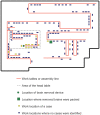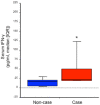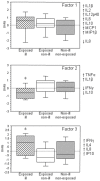Epidemiologic investigation of immune-mediated polyradiculoneuropathy among abattoir workers exposed to porcine brain
- PMID: 20333310
- PMCID: PMC2841649
- DOI: 10.1371/journal.pone.0009782
Epidemiologic investigation of immune-mediated polyradiculoneuropathy among abattoir workers exposed to porcine brain
Abstract
Background: In October 2007, a cluster of patients experiencing a novel polyradiculoneuropathy was identified at a pork abattoir (Plant A). Patients worked in the primary carcass processing area (warm room); the majority processed severed heads (head-table). An investigation was initiated to determine risk factors for illness.
Methods and results: Symptoms of the reported patients were unlike previously described occupational associated illnesses. A case-control study was conducted at Plant A. A case was defined as evidence of symptoms of peripheral neuropathy and compatible electrodiagnostic testing in a pork abattoir worker. Two control groups were used - randomly selected non-ill warm-room workers (n = 49), and all non-ill head-table workers (n = 56). Consenting cases and controls were interviewed and blood and throat swabs were collected. The 26 largest U.S. pork abattoirs were surveyed to identify additional cases. Fifteen cases were identified at Plant A; illness onsets occurred during May 2004-November 2007. Median age was 32 years (range, 21-55 years). Cases were more likely than warm-room controls to have ever worked at the head-table (adjusted odds ratio [AOR], 6.6; 95% confidence interval [CI], 1.6-26.7), removed brains or removed muscle from the backs of heads (AOR, 10.3; 95% CI, 1.5-68.5), and worked within 0-10 feet of the brain removal operation (AOR, 9.9; 95% CI, 1.2-80.0). Associations remained when comparing head-table cases and head-table controls. Workers removed brains by using compressed air that liquefied brain and generated aerosolized droplets, exposing themselves and nearby workers. Eight additional cases were identified in the only two other abattoirs using this technique. The three abattoirs that used this technique have stopped brain removal, and no new cases have been reported after 24 months of follow up. Cases compared to controls had higher median interferon-gamma (IFNgamma) levels (21.7 pg/ml; vs 14.8 pg/ml, P<0.001).
Discussion: This novel polyradiculoneuropathy was associated with removing porcine brains with compressed air. An autoimmune mechanism is supported by higher levels of IFNgamma in cases than in controls consistent with other immune mediated illnesses occurring in association with neural tissue exposure. Abattoirs should not use compressed air to remove brains and should avoid procedures that aerosolize CNS tissue. This outbreak highlights the potential for respiratory or mucosal exposure to cause an immune-mediated illness in an occupational setting.
Conflict of interest statement
Figures






References
-
- Centers for Disease Control and Prevention. Investigation of progressive inflammatory neuropathy among swine slaughterhouse workers--Minnesota, 2007–2008. MMWR Morb Mortal Wkly Rep. 2008;57:122–124. - PubMed
-
- State of Minnesota Office of the Revisor of Statutes. Minnesota Statute 144.05, General Duties of Commissioner. State of Minnesota Office of the Revisor of Statutes website. Accessed: January 2010. 2009. https://www.revisor.mn.gov/statutes/?id=144.05.
-
- State of Minnesota Office of the Revisor of Statutes. Minnesota Administrative Rules, Chapter 4605 Communicable Diseases. State of Minnesota Office of the Revisor of Statutes website. Accessed: January, 2010. 2008. https://www.revisor.mn.gov/rules/?id=4605.
-
- Lachance DH, Lennon VA, Pittock SJ, Tracy JA, Krecke KN, et al. An outbreak of neurological autoimmunity with polyradiculoneuropathy in workers exposed to aerosolised porcine neural tissue: a descriptive study. The Lancet Neurology. 2010;9:55–66. - PubMed
Publication types
MeSH terms
Grants and funding
LinkOut - more resources
Full Text Sources
Medical

